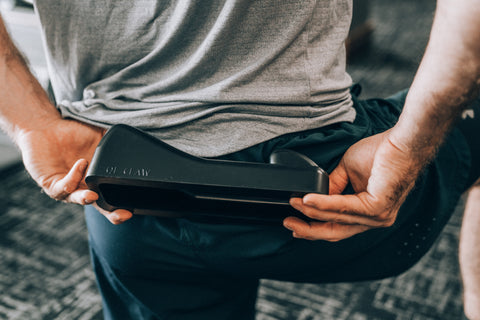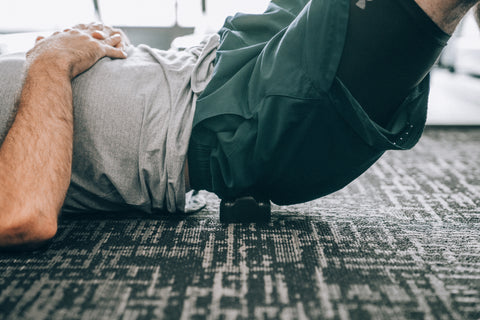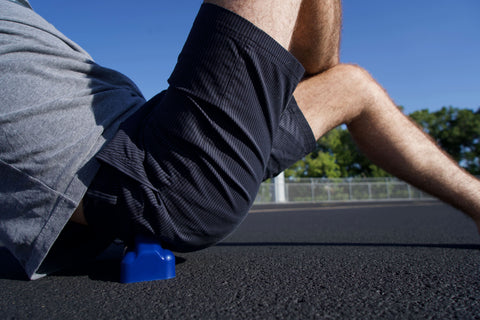Gluteus Medius pain is often overlooked as the source of lower back and glute pain. In this article we cover how to determine if Gluteus Medius is causing the pain, and more importantly how to fix it.
"The gluteus medius is at the top of the list of the many muscles that cause low back pain" [1] Travell & Simons (authors of the largest myofascial pain resource).
Gluteus Medius Pain Video
Gluteus Medius Pain Anatomy & Function
The Gluteus Medius is an upper buttock muscle. It is located in the pocket of the hip, or the highest part of the butt that has meat. Gluteus Medius lies underneath the better-known Gluteus Maximus, and lies on top of the lesser-known Gluteus Minimus [2].

Gluteus Medius Muscle
Gluteus Medius functions in hip abduction; or swinging the leg to the side of the body. Gluteus Medius holds us upright when standing on one leg, so it is highly active during dynamic physical activities - especially during sports. Gluteus Medius is engaged while doing anything on your feet, including:
- Playing sports with lateral movements
- Running
- Standing on one leg
Locate The Gluteus Medius Muscle:
To feel the Gluteus Medius function, stand on one leg without using your hands to balance. When standing on the right leg, the right Gluteus Medius contracts to prevent you from tipping to the left. You should feel a muscle engaging in the upper-side buttock area.

Gluteus Medius Location
Since Gluteus Medius is crucial in single-leg stability, it tends to be very strong in runners and athletes who play sports with lateral movement (tennis, soccer, basketball, hockey, etc.). Gluteus Medius also works hard while lifting objects, and can become strained if the load on the muscle exceeds its conditioning or capacity. It is for this reason that Gluteus Medius pain can arise in untrained folks trying to "do too much" while playing a sport or lifting an object.

Hip Abduction - A Function of the Gluteus Medius Muscle
Gluteus Medius Pain Patterns & Symptoms
Gluteus Medius Pain Patterns:
The Gluteus Medius muscle can cause a ton of pain in the lower back, glutes, and outer hip. The image below is from Travell & Simons work, which contains the most exhaustive muscle pain research ever conducted. It depicts in bright red where pain caused by Gluteus Medius can be felt on the body.

Gluteus Medius Pain Patterns [2]
Gluteus Medius Pain Symptoms:
Gluteus Medius pain generally feels like nagging lower back pain and pain along the upper buttocks. This pain can be triggered by a brief event such as lifting a couch, but also can occur gradually from performing physical activity over a long time. It is worth noting that Gluteus Medius is more susceptible to pain when it is cold and unprepared to work, as in jumping into a sport without warming up after sitting all day. Once Gluteus Medius is tight and in pain, being on your feet for too long can be very uncomfortable.
Additional Gluteus Medius pain symptoms:
- Flattened low back (loss of natural lumbar curve) - caused by a hyperactive, tight Gluteus Medius
- Pain from standing or walking for hours at a time
- Pain while lifting or carrying objects that should be easy
- Discomfort walking, climbing stairs, and running [2]
- Lower back pain when running
- Severe lower back pain while playing sports
- Inability to bend forward pain-free
Gluteus Medius Pain Relief
If Gluteus Medius pain is the problem, fortunately there are 3 consistent steps to relief. Perform them in order, and do not leave any of them out.
Step 1: Gluteus Medius Release / Massage
The root cause of Gluteus Medius pain is the knots, tightness, stickiness, and trigger points in the muscle. This causes constant tension in the muscle and pulls the pelvis posteriorly out of place. We start with massage/release as step 1 because when tightness and trigger points are present, stretching is extremely difficult and strengthening does not fix the constant pain [1].
To release the Gluteus Medius muscle, a lacrosse ball or a targeted tool like QL Claw can be used. I will only ever use QL Claw for Gluteus Medius release because it hooks in exactly where I need it, and the shape takes the guesswork out of the equation.



Gluteus Medius Pain Release Using QL Claw
QL Claw has written and video tutorials on Gluteus Medius release, as well as all other muscles (Psoas, QL, Iliacus, Piriformis, TFL) that could be causing lower back, hip, and glute pain. Learn more at the links below!
Step 2: Stretch
After opening the Gluteus Medius tissue with massage, you will be able to stretch the muscle back to its normal (or even an extended) length. One stretch that works well is the Pigeon Stretch. Another more moderate stretch you can do while sitting in a chair is this: Place one ankle on the opposite thigh. Lean forward or pull the leg to the chest to feel a deep stretch.
Step 3: Strengthen
Gluteus Medius pain usually happens in the first place because it is weak and/or unconditioned. A strong, flexible Gluteus Medius is armor against lower back pain; that is what we want to build from here out.
Here are a few of my favorite Gluteus Medius strengthening movements:
- Hip Abductions (standing or laying)
- Single Leg Deadlift
- Fire Hydrants
- Clamshells
- Standing on one leg with a neutral pelvis
- Running
Additional Gluteus Medius Pain Resources
Gluteus Medius is not the only muscle that can cause pain and problems in the lower back. If the steps above do not solve the problem, I recommend looking into other muscles like the Quadratus Lumborum (QL) and Iliacus. Just like Gluteus Medius, both muscles can cause severe lower back pain when tight. Save this page and check out these resources next to own the pain for good!
Gluteus Medius Pain FAQ:
What Causes Gluteus Medius Pain?
Trigger points, knots, and constant tension in the Gluteus Medius muscle causes pain by pulling on joints, impinging nerves, and creating discomfort.
Gluteus Medius Pain When Walking?
Gluteus Medius is crucial in walking, since it holds the torso upright while standing on one leg. If you have developed Gluteus Medius trigger points, walking can be extremely uncomfortable and feel like a nagging, throbbing lower back and upper buttock pain.
How To Treat Gluteus Medius Pain:
The first step is to release the Gluteus Medius muscle of its knots, trigger points, and constant tension. When done thoroughly, you should experience relief.
*If you do not find relief after several sessions of massage - Gluteus Medius pain is likely not the problem, and I would look at another potential pain source.
How Do You Release A Tight Gluteus Medius?
Deep tissue massage can be done by the hands of a professional physical or massage therapist, but you can also use a purposefully made tool like QL Claw at home.
Sources:
[1] Davies, Clair, and Amber Davies. The Trigger Point Therapy Workbook: Your Self-Treatment Guide for Pain Relief. 3rd ed., New Harbinger Publications, Inc., 2013.
[2] Donnelly, Joseph M. Travell, Simons & Simons Myofascial Pain and Dysfunction: the Trigger Point Manual. 3rd ed., Wolters Kluwer Health, 2019.


